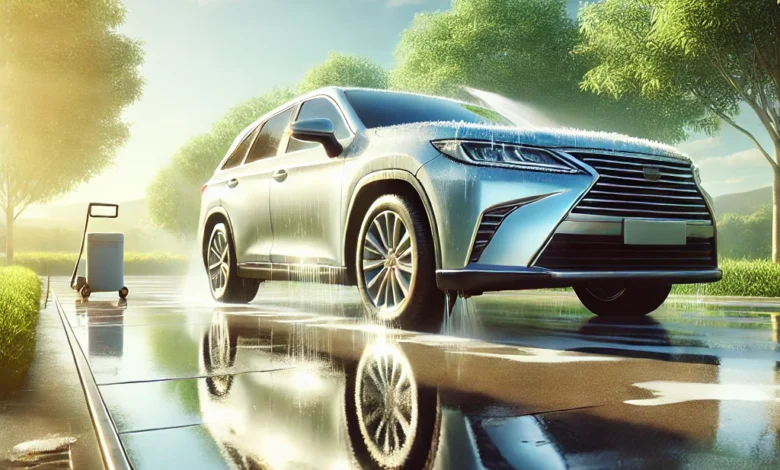The Best Car Wash & Maintenance Tips for a Showroom Shine

Having a car that looks brand new is a dream for many of us. Whether it’s the sleek shine of the exterior or the pristine cleanliness of the interior, a well-maintained vehicle always attracts attention and admiration. A car with a showroom shine not only looks great but also holds its value longer. In this article, we will share expert tips and techniques for achieving and maintaining a showroom-worthy shine. From the best practices for washing your car to essential maintenance tips that ensure your vehicle stays in top shape, we’ll cover it all.
In addition, proper car care is not just about aesthetics; it also helps in preserving the functionality of your vehicle. If you’re looking for comprehensive guidance on how to keep your car sparkling clean, the right Car wash & maintenance routine can do wonders. Below are the steps and tips that can help you get that perfect, long-lasting shine while ensuring your car stays in prime condition.
1. The Importance of Regular Car Washes and Maintenance
A car that’s cleaned regularly looks great, but there are several additional benefits to keeping up with a consistent wash and maintenance schedule. Not only does regular washing keep dirt and grime at bay, but it also helps protect your vehicle’s paintwork, preventing it from becoming scratched or faded over time.
Routine maintenance is just as important. It ensures that your vehicle runs smoothly, preventing breakdowns and extending the life of key components. This includes things like engine checks, fluid levels, and tire inspections. Consistently maintaining both the exterior and mechanical aspects of your car will lead to a cleaner, safer, and more durable vehicle.
2. Step-by-Step Car Wash Process for a Showroom Shine
Achieving that glossy, showroom-like finish is not just about the tools you use, but also the process you follow. Washing your car the right way ensures that you don’t scratch the paint or leave unwanted water spots. Let’s break down the steps for a perfect car wash.
2.1 Gather the Right Tools
Before you begin, gather all the necessary equipment. Here’s what you’ll need:
- A bucket with a grit guard to avoid dirt buildup.
- Microfiber wash mitts for gentle cleaning.
- Car-specific soap (avoid dishwashing detergent, as it can strip the paint’s protective wax layer).
- Two buckets (one for soap water and one for rinse water).
- A hose or pressure washer for rinsing.
- A microfiber towel or chamois for drying.
2.2 Rinse Your Car Thoroughly
The first step in the process is to rinse off any loose dirt, mud, or debris from the surface. This prevents any abrasive particles from scratching the paint while washing. A pressure washer can be a great option here, as it ensures that dirt is removed effectively.
2.3 Wash from Top to Bottom
Always start washing the car from the top, working your way down. The roof, windows, and hood will typically be the cleanest, and by washing from top to bottom, you avoid dragging dirt from the bottom onto the upper surfaces. Use your microfiber mitt in a circular motion, gently scrubbing each section. Don’t forget to frequently rinse the mitt to prevent dirt buildup.
2.4 Rinse Again and Dry
After washing the entire car, it’s time for another thorough rinse to remove all soap suds. Once done, dry your car using a microfiber towel or a chamois. This helps prevent water spots from forming on the paint. Drying is crucial to maintaining that showroom shine and avoiding damage.
3. Importance of Car Waxing for a Long-Lasting Shine
After a good wash, waxing your car is one of the most effective ways to protect the paintwork and ensure that glossy finish lasts longer. Car wax adds an extra layer of protection to the paint, helping to shield it from contaminants like bird droppings, tree sap, and harsh weather elements. It also helps in reducing water spots and making your car easier to clean the next time.
3.1 Choosing the Right Wax
There are various types of car wax available, including liquid wax, paste wax, and spray wax. Paste wax is known for offering a durable finish, while liquid wax is quicker to apply. Spray wax is the easiest to apply but tends to last the shortest. Choose the one that best fits your preferences and needs.
3.2 Applying the Wax
After your car is clean and dry, apply a thin, even layer of wax using an applicator pad. Work in small sections to avoid the wax drying before you have time to buff it. After applying, wait for the wax to haze, and then buff it off with a clean microfiber cloth. This step will leave your car with a deep, rich shine that’s protected from the elements.
3.3 The Benefits of Regular Waxing
Waxing not only adds shine but also provides protection from UV rays, water, and pollutants. Regular waxing (every 3-6 months) helps maintain that fresh look and protects the investment in your car.
Get professional car wash and maintenance tips for achieving a showroom-quality finish at thecaronline.com.
4. Detailing Your Car: The Key to a Showroom Finish
While washing and waxing are essential, detailing takes your car’s cleanliness and shine to the next level. Detailing involves thoroughly cleaning both the interior and exterior of your car, including areas you may not typically think to clean.
4.1 Exterior Detailing
This includes:
- Cleaning the wheels and tires: Use a dedicated wheel cleaner to remove brake dust and grime from your wheels. Apply tire shine for that extra touch.
- Cleaning the windows: Use a glass cleaner to remove streaks and smudges from all windows, including the windshield and mirrors.
- Polishing: After waxing, you may want to apply a polish for an even deeper shine. Polishing helps remove light scratches and enhances the gloss of the paint.
4.2 Interior Detailing
Interior detailing is just as important as the exterior. A spotless interior contributes to the overall luxury feel of your vehicle. To detail the inside:
- Vacuum thoroughly: Start with the carpets, seats, and floor mats. Don’t forget to vacuum the hard-to-reach areas.
- Wipe down surfaces: Use appropriate cleaners for the dashboard, door panels, and console. Be sure to use a microfiber cloth to avoid leaving streaks.
- Condition leather seats: If you have leather seats, use a leather conditioner to keep them soft and supple.
5. Tire and Wheel Care for a Perfect Finish
Tires are often overlooked when it comes to maintaining a car’s appearance. However, the state of your tires and wheels significantly impacts the overall look of your vehicle. Here’s how you can care for them.
5.1 Tire Maintenance
Check the tire pressure regularly to ensure they are inflated to the proper level. Under-inflated tires can wear unevenly, while over-inflated tires reduce traction. Additionally, rotate your tires every 6,000 to 8,000 miles to ensure even wear.
5.2 Cleaning and Shining the Wheels
Cleaning the wheels is essential to maintaining the overall look of your car. Use a wheel cleaner that’s designed for your type of wheels (alloy, chrome, or painted) to remove brake dust, dirt, and grime. After cleaning, apply a wheel protectant to help prevent brake dust buildup and enhance the shine.
6. The Role of Engine Care in Car Maintenance
While it’s essential to focus on the visual appeal of your car, keeping the engine bay clean is just as important for its longevity. A clean engine helps ensure the smooth operation of key components and can even improve performance in some cases.
6.1 Cleaning the Engine Bay
To clean your engine bay, first, cover sensitive components such as the battery and air intake with plastic bags. Use a degreaser to remove built-up grime, and then rinse with a gentle stream of water. Dry the engine bay with a microfiber towel to avoid water spots.
6.2 Regular Checks and Fluid Top-Ups
Regularly check fluid levels (oil, coolant, brake fluid, etc.) and top them up as necessary. This is crucial for keeping the engine running efficiently and preventing costly repairs.
7. The Importance of Regular Maintenance for Car Longevity
Routine car maintenance is the key to preventing major repairs and ensuring that your car runs smoothly for years. Regularly check and change the oil, inspect the brakes, and monitor the condition of the battery and other crucial components.
7.1 Changing Oil and Filters
Oil is the lifeblood of your car’s engine, and keeping it clean is essential for optimal performance. Make sure to follow the manufacturer’s guidelines for oil changes, typically every 3,000 to 5,000 miles, depending on the type of oil and your car’s needs. Don’t forget to change the oil filter as well.
7.2 Inspecting the Brakes
Your car’s braking system is vital for your safety. Inspect the brake pads and rotors regularly to ensure they are in good condition. Replace them if they are worn down.
8. The Importance of Interior Maintenance
Keeping the inside of your car clean and well-maintained is just as important as the exterior. A tidy interior creates a pleasant environment for both the driver and passengers, making your rides more enjoyable.
8.1 Clean and Condition Upholstery
Upholstery, whether cloth or leather, needs regular care. For cloth seats, vacuum and use a fabric cleaner to remove stains. For leather, use a conditioner to keep the material soft and prevent cracking.
8.2 Organizing the Interior
Maintaining an organized car interior helps keep it neat and comfortable. Invest in organizers for your trunk, glove box, and center console to reduce clutter. Regularly clear out trash and unnecessary items from your car.
9. The Benefits of Professional Detailing Services
While DIY car care can yield excellent results, there are times when professional detailing services can offer superior results. Professionals have access to advanced tools and techniques that can make your car look like it just came off the showroom floor.
10. Final Thoughts on Car Wash & Maintenance for a Showroom Shine
Achieving a showroom shine isn’t just about washing your car once in a while. It’s about consistent care, from the exterior wash to interior maintenance and mechanical checks. When done right, regular car wash & maintenance routines will keep your vehicle looking fantastic while helping it perform at its best.
11. How Seasonal Changes Affect Your Car and How to Prepare
One of the most important factors in car maintenance is preparing for the changing seasons. Each season introduces different environmental challenges, and if your car is not maintained according to the weather, it can lead to long-term damage.
11.1 Winter Maintenance Tips
Cold weather can be particularly hard on your car. Here’s how you can prepare:
- Use winter-grade windshield wiper fluid: This prevents it from freezing, ensuring clear visibility even in the harshest conditions.
- Check tire pressure: Cold weather can cause tire pressure to drop, affecting handling and safety.
- Protect the exterior: Salt and other de-icing chemicals can damage your paint. Regular washes, especially after driving on salted roads, can help prevent corrosion.
- Winterize the engine: Make sure your antifreeze levels are sufficient and check the condition of the battery. Cold weather can shorten the lifespan of a battery, so it’s important to test it regularly.
11.2 Summer Maintenance Tips
Summer brings its own set of challenges, including high temperatures and longer exposure to the sun. Here’s how you can prepare for the heat:
- Check the air conditioning: Ensure that your AC is working properly before the heat kicks in. Nothing’s worse than a hot car on a summer day.
- Use UV protection for the interior: The sun can cause the dashboard to crack and fade. Using a sunshade or applying a UV protectant to your interior surfaces can help protect them.
- Inspect the cooling system: Make sure the radiator and coolant levels are optimal. Overheating can cause serious damage to the engine, so check for any leaks or blockages in the system.
By staying on top of these seasonal maintenance tips, you can ensure that your car is always prepared for whatever nature throws at it.
12. The Role of Paint Protection Film and Ceramic Coating
If you’re serious about maintaining that showroom shine, it may be worth investing in additional paint protection options such as paint protection film (PPF) or ceramic coating. These treatments provide extra layers of protection that can help preserve your car’s appearance and increase its durability.
12.1 Paint Protection Film (PPF)
PPF is a transparent film applied to the exterior surfaces of your car. It serves as a protective barrier against stone chips, scratches, and other abrasions. The film is virtually invisible and can keep your car looking new for longer periods. Additionally, it helps maintain the resale value of your car by keeping the paintwork intact.
12.2 Ceramic Coating
Ceramic coating is a liquid polymer applied to the exterior of your car that bonds with the paint, creating a hydrophobic surface. This means water, dirt, and grime will have a much harder time sticking to the surface, making your car easier to clean. The coating also adds a deep, glossy shine and provides long-lasting protection against UV rays, bird droppings, tree sap, and other contaminants. It’s a great way to enhance your car’s shine and make maintenance easier.
12.3 How to Care for PPF and Ceramic Coating
Even with PPF or ceramic coating, regular washing and maintenance are still crucial. While these coatings can help protect against dirt and debris, they don’t eliminate the need for proper care. Be sure to wash your car with the right products and avoid harsh chemicals that may damage these coatings.
13. Common Car Wash Mistakes to Avoid
Even with the best tools and intentions, certain mistakes can lead to undesirable outcomes when washing your car. To ensure that you don’t damage your paint or waste time, it’s important to avoid some common car washing mistakes.
13.1 Using Household Detergents
It’s tempting to grab any soap you have around the house, but using dishwashing or household detergents can strip away the protective wax layer on your car’s paint. Always use a dedicated car wash soap designed to be gentle on the paint while still removing dirt effectively.
13.2 Washing in Direct Sunlight
Washing your car in direct sunlight may seem like an efficient way to get it done quickly, but the sun can cause water spots and soap streaks to form on the surface. It’s best to wash your car in the shade or during cooler times of the day, such as early morning or late afternoon.
13.3 Not Drying Your Car Properly
If you don’t dry your car after rinsing, you risk leaving water spots or streaks on the paint. Always make sure to dry your car thoroughly with a microfiber towel or a chamois to preserve the shine.
13.4 Using a Dirty Cloth or Sponge
Using a dirty cloth or sponge can transfer grime back onto your car, leading to scratches. Make sure you rinse your wash mitt or cloth often and clean it thoroughly after each use.
14. Engine Maintenance Tips to Keep Your Car Running Smoothly
While maintaining the exterior and interior is crucial for keeping your car looking good, engine maintenance plays a big role in ensuring the longevity and performance of your vehicle. A well-maintained engine not only runs better but also improves fuel efficiency and reduces the risk of costly repairs.
14.1 Check the Engine Oil Regularly
Oil is the lifeblood of your engine, so make sure to check the oil level frequently. The oil keeps the engine parts lubricated, reducing friction and wear. If you notice the oil is dirty or low, it’s time for a change.
14.2 Monitor the Cooling System
The cooling system keeps the engine from overheating. Regularly check the coolant levels and ensure that the radiator is functioning correctly. If you notice any leaks, address them right away to avoid engine damage.
14.3 Change the Air Filter
The air filter prevents debris from entering the engine, ensuring that the engine receives clean air for optimal combustion. Check the air filter periodically, and replace it if it’s dirty or clogged. A clogged air filter can reduce engine efficiency and performance.
14.4 Keep the Battery in Check
The battery powers all electrical components in your car, and a dead battery can leave you stranded. Check the battery regularly to ensure it’s charged, and inspect the terminals for any corrosion. If your battery is old or showing signs of wear, it’s a good idea to replace it before it fails.
15. Final Words on Car Wash & Maintenance for a Showroom Shine
Achieving a showroom shine requires more than just the occasional wash. It’s about adopting a regular routine of washing, waxing, detailing, and overall maintenance to keep your car looking and running like new. With the right tools, techniques, and a little bit of care, your car will not only look stunning but also provide you with the reliability and longevity you deserve.
If you take the time to properly maintain both the appearance and mechanical functions of your car, you’ll reap the rewards for years to come. From a clean exterior and interior to a smoothly running engine, your car will always feel like it’s fresh off the showroom floor. Keep up with your car wash & maintenance routine, and enjoy the pride that comes with driving a vehicle that looks and feels brand new.


